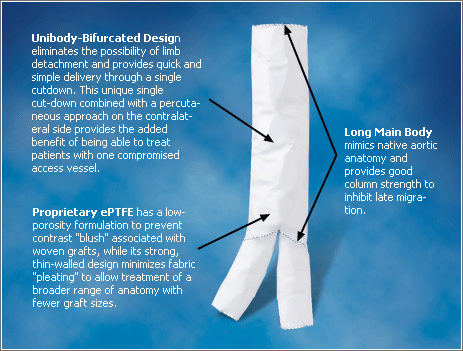An abdominal aortic aneurysm (AAA) is a weakening of the wall of the aorta (the largest artery in the body), resulting in a balloon-like enlargement. If left untreated, the aorta will continue to enlarge and become more susceptible to rupturing. When an AAA ruptures, patients will experience pain, fainting, and loss of consciousness that frequently leads to shock and death. Open surgical repair is currently the most common treatment for AAA. It is highly invasive and often requires long hospital stays.
 Endologix’s Powerlink System is a minimally-invasive procedure, using a one-piece, self-expanding device with a durable cobalt-chromium stent. The stent graft is attached to the aorta and diverts blood away from the weakened area. The unique delivery mechanism requires only a small incision in one leg (via the femoral artery), allowing the Powerlink System to be used in patients with small access vessels. A video of the procedure can be found here.
Endologix’s Powerlink System is a minimally-invasive procedure, using a one-piece, self-expanding device with a durable cobalt-chromium stent. The stent graft is attached to the aorta and diverts blood away from the weakened area. The unique delivery mechanism requires only a small incision in one leg (via the femoral artery), allowing the Powerlink System to be used in patients with small access vessels. A video of the procedure can be found here.
New long-term data indicates that Powerlink is just as durable in protecting patients from aneurysm-related death as open repair. The Powerlink-treated cohort demonstrated significant aortic aneurysm sac shrinkage and straightening, which proved instrumental in avoiding late complications and reinterventions.
Published in the September issue of the Journal of Vascular Surgery, six-year patient follow-up data gathered from the company’s pivotal clinical trial supports the durability of the Powerlink System as a minimally invasive treatment for AAA.
Previously, a four-year follow-up showed that 97.9% of patients were free from AAA mortality with no aneurysm ruptures and no graft material failures or fractures. Current treatment alternatives are much more invasive and carry high surgical morbidity and mortality.
Each year 190,000 persons are diagnosed with AAA in the U.S.; 50,000 undergo surgery. Analysts estimate that the market for the endoluminal stent graft (ELG) treatment for AAA is $300-350 million. Seventy to eighty percent of AAA patients are asymptomatic at the time of initial diagnosis and AAA is discovered inadvertently during procedures used to diagnose unrelated medical conditions. The U.S. Congress passed the SAAAVE bill that will benefit ultrasound AAA screening beginning January 2007.